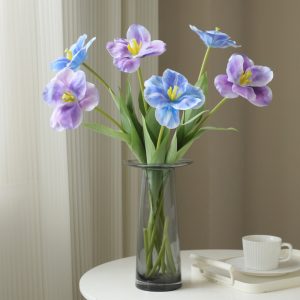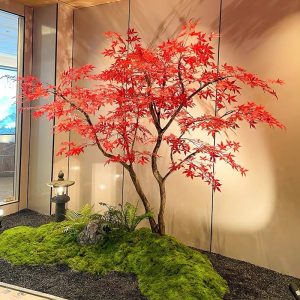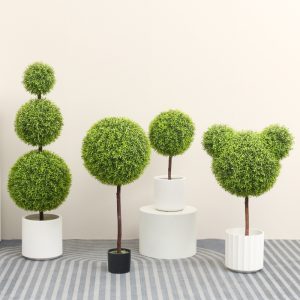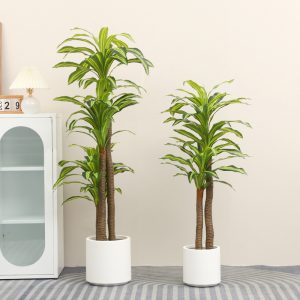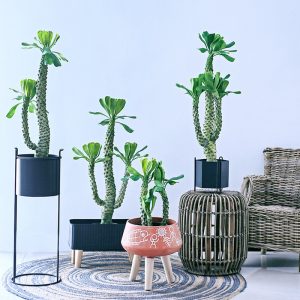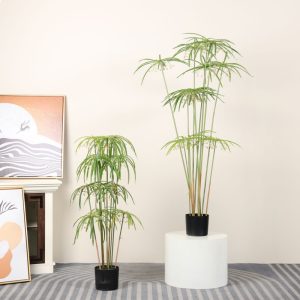At 7:00 AM in the lobby of the Lisbon InterContinental Hotel, sunlight filters through the arched windows, casting dappled shadows on the marble floor. My colleague Emma stands in the lounge area beside the reception, her fingers lightly brushing a heart-shaped leaf, turning with a smile: “Look at the veins under the light, they look like they just came from a tropical rainforest. Who would’ve guessed this is the hotel’s artificial heart-leaf ficus?” The scent of coffee and woodsy essential oils blend in the air, and the vibrant greenery instantly softens the sterile commercial space.
As I push open the revolving door, the first thing that catches my eye is not the reception desk, but three staggered groups of artificial heart-leaf ficus. The tallest stands at 2.2 meters, with branches and leaves reaching nearly to the crystal tassels of a vintage chandelier, while the shorter ones rest on either side of the sofa, forming a natural boundary for conversation. Emma leans in, pointing to the petioles with a smile: “Look at the faux fuzz here, the way the sunlight hits it is just like the real thing. When I brought clients here last week, they all thought it was real, meticulously maintained greenery.”

The lobby’s furniture features a classic combination of dark walnut wood and off-white leather, and the addition of artificial heart-leaf ficus adds liveliness to the space. At noon, the brightest sunlight shines through the windows, creating dancing spots of light on the walls; in the evening, the warm lights give the deep green leaves a golden halo, complementing the glow of the fireplace. Lisa, in charge of soft furnishings, stops and remarks: “We tried real fiddle-leaf figs before, but Lisbon’s winter light wasn’t enough, and within three months, the leaves turned yellow and dropped off. Swapping in these artificial heart-leaf ficus plants saved us the cost of weekly maintenance, and even the housekeeping staff says the dust is easier to manage.”
“We argued for a long time about which plants to use,” Emma says, leading me to the display area by the elevator hall, where artificial heart-leaf ficus are planted in brass containers, forming a perfect balance with the geometric artwork on the walls. “The client wanted a ‘natural look at first glance,’ but the old European hotels have low ceilings and uneven light. Real plants either can’t survive the winter, or need constant replacement, which drives labor costs too high.” She points to the faux dew on the leaves, “We were shocked when we saw the sample. This food-grade silicone material isn’t just waterproof and UV-resistant, the drooping effect of the leaves is just like that of a five-year-old real tree.”
Mark from the engineering department joins the conversation during his rounds: “I was watching the installation that day, didn’t expect it to be so low-maintenance. The base has hidden stabilization, so there’s no concern about it tipping over during a storm. The best part is the eco-friendliness—no pesticides required like with real plants, and it’s safe for the guest rooms.” He points to the corner of the corridor, where an artificial heart-leaf ficus pairs with a vintage cabinet, and the shadows of the leaves create natural patterns on the carpet. “A Parisian designer was here last week and specifically asked for the brand when they took a picture.”
In the afternoon at the executive lounge, sunlight streams through the Venetian blinds, landing on the artificial heart-leaf ficus near the window. A few business guests sit around, occasionally brushing the leaves that hang down to the table. Emma whispers, “Did you notice? Unlike plastic fake plants, this one doesn’t have that ‘cheap’ feel. The leaves are different shades, the branches curve naturally, and guests don’t shy away from it—they interact with it like it’s a real plant.”
Maria from the housekeeping department walks by with linens, smiling as she adds, “The small artificial heart-leaf ficus in the guest rooms are the most popular! Especially in the north-facing rooms, real plants never did well there. Now, with these artificial heart-leaf ficus, guests often ask where they can buy them when they check out. Once, a guest from the US even asked for a cleaning guide, saying they wanted to put one in their home.” She points to the suite’s entryway, “We adjust the height based on the room style: modern rooms use tall, slim pots, and vintage rooms use chunky clay ones. Guests say it feels like staying in a villa with a personal gardener.”
As night falls, the lobby lights dim, and the artificial heart-leaf ficus take on a warm glow under the soft lighting. Emma gazes at the gently swaying greenery in the breeze and says, “The essence of a hotel is to make people feel at home in a foreign city, and nature is the best comfort. This artificial heart-leaf ficus, which requires no care yet stays vibrant, has become the hotel’s most worry-free green companion.”
When the last guest happily leaves, the duty manager gently closes the glass door. Under the moonlight, the artificial heart-leaf ficus in the lobby still stretch their leaves, using their eternal greenery to guard the warmth and poetry of the city. For European and American hotels that prioritize quality and efficiency, this greenery is not just decoration, but a living aesthetic that stays green year-round without the wait.







